Gates and wickets made of profiled sheet

Gates and wickets made of profiled sheet
Fencing a summer cottage or the perimeter of a house will not only create a comfortable stay for their inhabitants, but also decorate the appearance. However, not everyone has the opportunity to build a brick fence. In this case, an alternative option will come to the rescue: a profiled sheet.
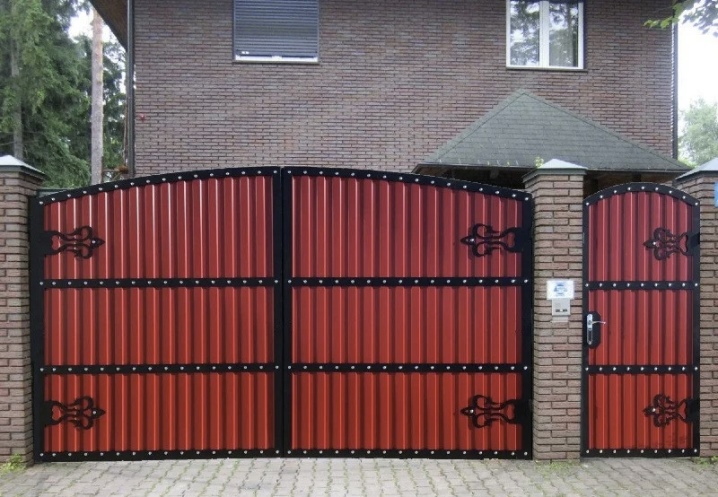
Peculiarities
The scope of application of corrugated board is extensive... It is used as a roofing material, for wall cladding, gates and wickets are made. Since the corrugated sheet is a building material for outdoor work, it is made of galvanized steel.

Decking has a number of features.
- Giving a curly profile increases the rigidity of galvanized plates. This makes the profiled sheet resistant to many mechanical influences.
- Anti-corrosion the coating will protect the metal from rusting.
- Extensive selection decorated options will allow you to choose a corrugated board for every color and taste. Simpler monochromatic versions, patterned, as well as corrugated sheets with diverse patterns are produced.
- Thanks to lightness it becomes much more convenient to use a professional sheet. For the stability of the structure, small beams will be enough. Also, there is no need to use special equipment.
- The low price will also delight buyers... After all, the cost of a professional sheet is about 270 rubles, while a brick costs from 7.50 to 25.50 rubles. a piece. But the construction of the same fence of galvanized plates will require significantly less than bricks.


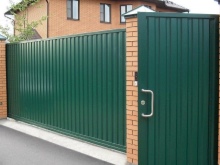
Of course, there are also downsides.
- There is no sound insulation for the corrugated board. This material, on the contrary, amplifies the sound at times. You need to take this into account when planning to make a wicket from a profiled sheet. Of course, this can be a plus for a large private home. In this case, there will be no need to place a call, because any knock will be perfectly audible.
- If the protective coating is damaged, the corrugated sheet loses its anti-corrosion properties.



Varieties
The types of professional sheet gates are very diverse. They stand out for their design, decor, and waveform.
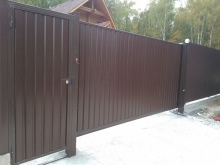


Swing
The simplest and cheapest option in comparison with the others. The structure is arranged as follows: metal doors are attached to two pillars concreted in the ground. Fastening is done using cylindrical hinges. The wicket can be built into one of the leaves or attached separately. The disadvantage is the need for empty space on the outside and on the inside.
Opening the wicket door is especially difficult during gusty winds.



Recoil
The device of a sliding gate is similar to compartment doors in trains. On a solid foundation with reinforcement, a structure of roller bearings is installed, which make up the guide rail. It is also very important to correctly calculate the counterweight to make the gate easier to open. This design can last 15-20 years, however, it is very difficult to install it yourself.
Any inaccuracy in the calculations can lead to the unsuitability of the gate.

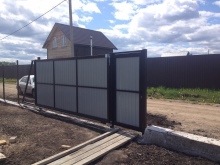

Sliding
This option is a branch of the sliding gates, since they have a similar principle of operation. The difference is in the complicated design. Sliding gates consist of two leaves. Basically, this type is used in enterprises where the gate opening is wide enough.The mechanism with integrated guide rail and profile is designed for a door opening of more than 5 meters.



Automatic
In addition to the manual method of opening the gate, there is an automatic one. It consists in installing an electric drive, which will allow you to open the gate using the remote control, while remaining in the car. Most often, sliding gates are automated, since other structures lend themselves to this procedure is quite difficult.



Decorated
The variety of decor allows you to install various gate options. In addition to monochromatic types, professional sheet gates can be beautiful with forging elements. Forged gates are heavier and require additional mortgages when building a foundation. However, such a design will look impressive both outside and inside. Iron sheets can be corrugated up and down. They have a wavy and trapezoidal surface.


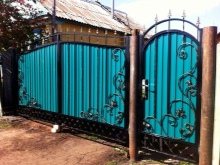
Selection and calculation of material
The choice of material should be based on the desired door height. You also need to take into account the design and color of the finished product. The design will also affect the cost of the corrugated board. The most budgetary option: swing gates made of profiled sheet 1X2. In addition to focusing on price, you need to pay attention to the external characteristics of corrugated sheets. It is better to choose a house or summer cottage suitable for the appearance. So the gate and wicket will look harmoniously against the general background.
When calculating materials, the material of the bearing pillars is also taken into account. They can be wooden or metal, round and square. You can perform the necessary calculations in the online calculator. In the empty fields, you need to enter the height and width of the gate, mark the presence or absence of a wicket, indicate the size of the posts and frame.
On average, the cost of self-installation varies from 10,000 to 15,000 rubles.



How to do it yourself?
Corrugated gates are suitable for home and summer cottages. It is possible to weld a simple swing gate without having much experience in welding. To correctly make the sash from the corrugated board yourself, you need to do the preparatory steps. First you need to decide on the width and height of the structure. It is necessary to measure the selected location. Next, choose the material of the bearing pillars. They can be wooden or metal. Then the loops are selected, with the help of which the profiled sheets are attached to the support.
After that, you can start drawing the circuit. Usually the height of the gate depends on the height of the fence and does not exceed 2 meters. If the fence is 3-5 meters high, additional jumpers are made from above to the gate and wicket, which are then covered with corrugated board. The optimal opening width is 1-1.5 meters.
With an increase in width, the structure will become heavier, which can lead to a skewed door.



Preparation
When the choice of design and dimensions is complete, you need to prepare all the necessary materials. The amount of building materials can be calculated based on the drawing made. To make swing gates and wickets from a profiled sheet, you will need the following.
- Profiled sheet with a protective coating. The optimum thickness is 0.5-1 mm. It is worth choosing profiled sheets with a small wave height - about 10 mm.
- Self-tapping screws roofing with rubber gasket.
- Iron pipes as support pillars. Recommended size 80X80. If only a wicket door is manufactured, one 60X60 pipe will be sufficient. Beams welded from channels can be used as a supporting structure.
- Metal beams 40X40 or 60X40 required for the base of the wicket.
- Priming anti-corrosion for metal.
- Weather resistant dye.
- Looped fastenings.
- Lock.
- Cement, crushed stone, sand.
- Gravel or coarse gravel.
- Welding electrodes.



Of the tools you will need such.
- Welding device.
- Grinder with attachments for metal processing.
- Measuring instruments: ruler, tape measure, square.
- Chalk, scribe.
- Level, plumb.
- Screwdriver and drill.
- Vices or clamps.
- Garden drill.
- Concrete mixer.If not, you will need a container for mixing the solution.
- Garden and shovels.
- Armature.



Installing racks
You need to install the racks first... For this, the center of the future pits is marked with a cord. Measurements are carried out along the line with the fence. Then they drill or dig holes about 1.2-1.5 meters deep. Sand is poured at the bottom and pressed down to 0.1 m in thickness. Then gravel or large crushed stone is poured in a layer of no more than 0.2 m and tamped.
Rack blanks should be 1.2 - 1.5 m higher than the required height. This part will be recessed. To increase the stability of the pillars, iron plates are welded to the bottom. To increase the strength of the foundation, roofing material laid along the edges of the pit will help.
Racks are installed in the prepared pits, poured with concrete, leveled with a level and secured with spacers. The finished concrete must be carefully pierced with reinforcement to prevent the formation of bubbles. In this state, the structure is left for 8-15 days until the concrete dries.
For several days, you need to moisten the solution so that it does not crack.



Sash
It is imperative to start working with welding in protective clothing, consisting of a canvas suit, gloves, welding goggles and boots... To begin with, the pipes are cut to the desired length. Cut them at an angle of 45, and pipes intended for lintels, at an angle of 90. The roughness left after trimming is cleaned, the rust is sanded. This will improve the quality of the seam.
Parts for welding must be located strictly horizontally. It is advisable to use a special table. In its absence, the blanks can be placed on the site near the house or summer cottage. Details for the frame are fastened with clamps. Before you start cooking, you need to check again if the pieces are positioned correctly. First, lightly grab the frame. After that, you need to check the corners and diagonals. It is necessary that they match. Then the joints are welded with a continuous seam.
So that the frame does not deform, it is recommended to carry out welding interruptions. This will allow the metal to cool down. When the frame is welded, you can start welding the crossbars. Their location is different: horizontal, crosswise, diagonally. It depends on the size of the gate and wicket and the expected result. The welding process is no different from welding the frame. First, the parts are cut to the desired length, cleaned, fastened with clamps. Then they grab it slightly. After checking, weld with a continuous seam.



Installation of corrugated board
In order to install the sashes, it is necessary to weld the hinges... To do this, the sashes are propped up with wedges and beams at the height required for the wicket. First, the upper loop is applied and tacked with a dotted seam, then welded. The same is done with the lower loop. After checking the correct location, the hinges are welded to the frame. When the seams have cooled, the wedge-shaped supports are removed. Then the height of the supports is checked. If the height is greater, the struts can be trimmed and trimmed. The top hole in the pipe is welded using a metal sheet. Having measured the location of the castle, a slot is made for it with a grinder. After the holes for the self-tapping screws are drilled in the gate, the lock is removed.


Before sheathing with profiled sheets, the frame is sanded, covered with anti-corrosion primer, painted in two layers with weather-resistant paint... The corrugated board is laid so that the undulating recess lies on the frame from the side of the lock. Measure the dimensions of the corrugated sheet, note the dimensions of the slots for the loops. The metal sheet is cut with a grinder, cut out slots for the hinges, drilled out a place for the lock. The sections of the profiled sheet must be cleaned with a file, covered with an anti-corrosion solution, and painted with weather-resistant paint. This will protect the structure from premature rusting.
The corrugated board is screwed to the supports with roofing screws. Then the lock is installed. This completes the manufacturing process of swing gates with a wicket made of profiled sheet. If you wish and diligence, you can independently make a gate from corrugated board.
It is worth carefully following the instructions and not skipping the preparatory steps.


You can learn how to make a gate with a wicket from a profiled sheet with your own hands from the video below.













The comment was sent successfully.